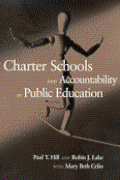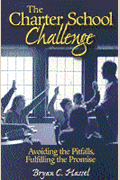Studies in this week’s Hutchins Roundup find that PPP loans increased businesses’ likelihood of survival, but didn’t always make it to the right businesses, charter schools improve the quality of traditional public school’s labor pool, and more.
Want to receive the Hutchins Roundup as an email? Sign up here to get it in your inbox every Thursday.
PPP loans increased businesses’ likelihood of survival, but loans didn’t always go to the businesses who needed them most
In response to the pandemic, the federal government offered up to $649 billion in government-guaranteed Paycheck Protection Program (PPP) loans via commercial banks to small- and medium-sized firms. Leaving loan administration to banks allowed for a faster transfer of funding, but did banks distribute loans to businesses who needed them most? Using firm-level survey data from the Alignable network, Alexander Bartik of the University of Illinois at Urbana-Champaign and co-authors find that PPP loan approval increased firms’ probability of survival by 14 to 30 percentage points and also boosted employment, although that effect is measured imprecisely. Along some dimensions, including payroll size, banks did appear to target loans to businesses that might have failed without the cash infusion. But businesses that reported larger revenue losses from the pandemic and lower cash savings were less likely to be approved for a loan, despite experiencing greater positive impacts when they did receive funding. Some banks appear to have prioritized firms with closer relationships to the bank and those in better financial condition, possibly passing over businesses who would have benefited more from the program.
Charter schools improve the quality of traditional public schools’ teacher pool
Using data from charter and traditional public schools from the Massachusetts Department of Elementary and Secondary Education, Jesse M. Bruhn at Brown, Marcus A. Winters at Boston and Scott A. Imberman at Michigan State track the movement of teachers between and within charter and traditional public schools in their first seven years. They find that charter schools are more likely than traditional public schools to lose both their lowest and highest performing teachers. Moreover, low-performing teachers are more likely to exit the profession entirely while high-performing teachers are more likely to move from charters into traditional public schools where employment protections are stronger and wages are higher. In addition, their data show that the probability a charter school teacher moves to a traditional public school increases substantially once he or she becomes licensed—a standard almost always required by traditional public schools. The authors conclude that charter schools provide potential teachers who aren’t licensed with a low-cost, low-barrier avenue to test their taste and aptitude for teaching and, by sorting teachers, charter schools increase the size and quality of traditional public schools’ labor pool.
Extending duration of unemployment insurance leads to better job matches
While some economists argue that unemployment insurance (UI) may prolong unemployment by inducing jobseekers to put less effort into job search, Ammar Farooq at Uber Technologies, Adriana D. Kugler and Umberto Muratori at Georgetown find that extending UI benefits during recessions allows job-seekers to search for a better job match. Using employer- and employee-level data from the Longitudinal Employer-Household Dynamics survey and household-level data from the Current Population Survey, the authors rank each employee and job by wage, quality, and education or educational requirements. Focusing on the Great Recession, they find that a 53-week increase in UI benefit duration increases wages between 2.6% and 4.4%, increases the similarity between worker and firm quality rankings by 1.1%, and increases the likelihood that workers end up in jobs with higher education requirements by 14.4%. The authors argue that since there is no evidence that recessions affect the skill requirements of firms, workers are finding jobs that better match their education. These effects are larger for women, non-whites, and less-educated workers.
Chart of the week: Telework by Education Level
Quote of the week:
“The course of the economy is going to depend on the course of the virus, and mitigation efforts… [M]y baseline view is we’ll get a bounce back in the Q3 data, but it’ll take some time before we get back to the level of activity we had in February before the pandemic hit….We could get back to the level of activity [we had before the pandemic] perhaps by the end of 2021, but there are a lot of moving parts here with the virus and the global outlook so I think there is a pretty big range of uncertainty. I do think economic activity did begin to pick up in May and June and my personal forecast is that will continue through the second half of the year… [But] the longer this drags on, the greater risk there is to long-term damage to the economy. I don’t think we’re at that point yet,” says Richard Clarida, Vice Chairman of the Federal Reserve Board.
“We did discuss at our July meeting our framework review… The committee recognizes that the world today looks a lot different than it did in 2012, the last time the Fed did a serious review. In particular, there are very powerful global disinflationary forces and there are also very powerful forces holding down global rates. If you put those two together, it does suggest that there could be ways we can define our strategy so we’re better able to achieve our objectives of maximum employment and price stability…We are certainly looking at some important evolutions from our strategy from our existing strategy.”











Commentary
Hutchins Roundup: PPP loans, charter schools and more
August 6, 2020